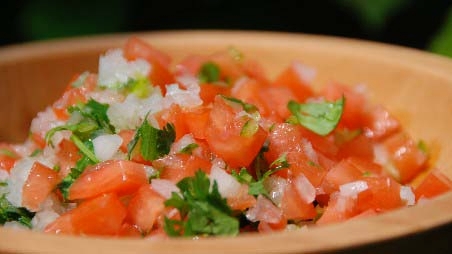¡Salsa! It’s more than a flavorful condiment
Salsa plays a much-deserved starring role in Mexican cuisine, adding not only refreshing and spicy flavors to breakfast, lunch, snacks and dinner, but also conveying an ample supply of nutrients.
A blend of fruits, vegetables and seasonings, salsas are created almost entirely from the foods highly recommended by nutrition experts, says UC Cooperative Extension nutrition educator Margarita Schwarz.
“Experts recommend we eat 3 to 5 servings of vegetables and 2 to 4 servings of fruit daily and salsa is an excellent way to add these foods to our diets,” she said. “We can experiment in the kitchen with different blends, combining flavors that are sweet, acid and picante to create a dish that’s delicious and healthful.”
Schwarz said there are a wide variety of salsas:
- Fresh salsa (also known as pico de gallo, which in Spanish is literally “rooster’s beak”) is made with chopped tomato, chili pepper, onion, cilantro, lime juice, salt and pepper
- Salsa ranchero uses similar ingredients but the mixture is blended or grinded until almost smooth
- Salsa verde (green salsa), in which the main ingredient is tomatillo, a tart fruit related to cape gooseberries
- Guacamole is a sauce with avocado as the base
- Mole is a dark-colored sauce made of roasted chili peppers, spices, chocolate and sometimes squash seeds
- Corn salsa combines fresh salsa ingredients with a generous amount of cooked corn kernals
- Mango salsa is a chunky, colorful blend that combines the sweet, tropical taste of mango fruit with onions and spices
In the late 1990s, it was widely reported that salsa sales surpassed ketchup sales in U.S. grocery stores. That’s a good thing. Ketchup contains sugar, and salsa generally has none. Salsa is low in calories and contains little to no fat. The tomatoes, chilies and cilantro in salsa have vitamins A and C and the tomatoes contribute potassium to the diet. The avocado in guacamole contains fiber, vitamin B6, vitamin C and potassium.
“Sometimes people will say: ‘I don’t eat avocados because they have fat,’ but this is the fat that the body needs and that can help prevent cardiovascular disease,” Schwarz said
Salsa is the Spanish word for sauce, but the mixture was a staple of Latin American indigenous cuisine long before the Spanish conquest. Tomato, avocado, tomatillo and many hot peppers are native to Central and South America.
The other “salsa,” a popular Latin dance, is also good for the heart, Schwarz said. The salsa originated in Cuba and Puerto Rico, but all of Latin America has incorporated it into their musical lexicon. Salsa’s fast tempo makes it such a lively physical activity, some health clubs offer salsa classes for aerobic exercise.
Mango Salsa
Following is a mango salsa recipe from the UC Expanded Food and Nutrition Education Program curriculum:
Ingredients:
1 mango, peeled, pitted and diced (or 1 cup thawed frozen mango chunks)
1 tablespoon diced red onion
1 tablespoon chopped fresh or dried cilantro (optional)
¼ teaspoon salt
Juice of 1 lime or 2 tablespoons bottle lime juice
Directions:
- Combine all ingredients in a bowl
- Serve with baked tortilla chips or us as a garnish for chiken or fish.


Posted by california bar attorney search on June 7, 2011 at 9:21 PM